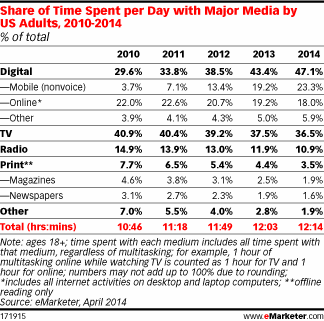
 Editor’s note: The new issue of our sister publication Nieman Reports is out and ready for you to read, online and in print.
Editor’s note: The new issue of our sister publication Nieman Reports is out and ready for you to read, online and in print.
There’s lots of great stuff in there as usual, with articles on the state of journalism education, citizen journalism in Turkey, comics journalism, epic poetry (!), and more.
I write a column for the print edition of the magazine. Here’s mine from the new issue.
It almost seems unfair — a case of double jeopardy.
Traditional news organizations have spent the past decade responding to an enormously disruptive piece of technology: the web browser. Their old monopolies, their old claims on the audience’s attention, were broken by a platform that let anyone publish — no printing press or broadcast tower required. The impact on their business models, particularly at newspapers…well, you know all about that.
But just when news organizations were starting to feel more at home on the web — just when, in many newsrooms, digital was no longer being treated as a sad sister to print — along comes another blow-up-the-model moment: mobile.
It would be an exaggeration to say that the rise of the smartphone is a shift on par with the rise of the web. But it wouldn’t be that much of one. Seven years after the iPhone, smartphones have moved from a tool of the tech elite to a handheld computer in everyone’s pocket. They’re radically changing how people are getting their news. And I fear that many news outlets still haven’t wrestled with how big a change they represent.
 New data from eMarketer estimates that, in the United States, about 23 percent of Americans’ total media consumption in 2014 will come on mobile devices. That’s counting all media formats, including television, radio and print. Mobile’s already ahead of the total for laptops and desktops, 18 percent. And its share will keep growing as networks get faster and devices get cheaper.
New data from eMarketer estimates that, in the United States, about 23 percent of Americans’ total media consumption in 2014 will come on mobile devices. That’s counting all media formats, including television, radio and print. Mobile’s already ahead of the total for laptops and desktops, 18 percent. And its share will keep growing as networks get faster and devices get cheaper.
But those numbers hide the fact that traditional news outlets are being outcompeted for mobile users’ attention. Data from comScore shows that while consuming newspaper content takes up a mere 0.9 percent of total connected time on desktops and laptops, the total’s even worse on phones — just 0.2 percent.
Aren’t phones just web browsers with smaller screens? Not really. Smartphones are personal, social machines, optimized for communication and entertainment. Offered the choice, there are lots of people who’d rather spend time with Flappy Bird than The Fresno Bee. The tap-and-scroll interface works beautifully with social networks like Facebook and Twitter — less so with old-fashioned news presentation. And an interface built around apps and icons can make it a challenge for any single news source to earn a prominent spot on someone’s home screen.
The other big challenge is — surprise, surprise — money. Online advertising has long been dominated by a few big players, but their market power is even stronger on mobile. Just two companies — Google and Facebook — will earn 68.5 percent of all the mobile advertising revenue worldwide in 2014. They can do so because they have the best data about individual users: Google knows what you’re searching for, Facebook knows who and what you like. That advantage is almost impossible for a small news outlet to beat. The Newspaper Association of America estimates that mobile ads contributed less than 1 percent of all newspaper revenue in 2013.
So: News outlets are watching their audiences move rapidly to a new platform — one where they have a number of competitive disadvantages and where they have a hard time making money. Sound familiar? You can be excused for thinking 2014 sounds a lot like 2004.
Part of the problem is that many news organizations, seeing this new generation of devices, made a bad bet. They decided that tablets, not smartphones, were the place to invest. Magazines, in particular, spent many millions building interactive iPad apps that promised to transfer the magazine-reading experience to a flat piece of glass about the same size.
These apps were often lovely. They were also often slow to download, clunky to use, and papered over with only the thinnest layer of interactivity.
Publishers thought tablets would be a chance to retake control of the publishing channel. Anyone can publish on the web, they thought, but not everyone can create an experience like this; it’ll be a recreation of the old evening newspaper, a lean-back read that they’re uniquely able to provide.
That tablet boom never came. Most of those fancy magazine apps sunk into disuse, never attracting the kind of subscription numbers publishers hoped. Sales of the iPad, the most popular tablet and the one most publishers targeted, fell this spring, year-over-year. Cheaper Android tablets keep selling, but there’s little evidence people are paying for news on them en masse. Research from Ball State University found that, among college students, the percentage owning a tablet actually declined between 2012 and 2014.
Meanwhile, social networks took over the phone. Journalists spend a lot of time on Twitter, and everyone knows about Facebook. But other platforms — YouTube, WhatsApp, Instagram, Vine, Snapchat — are also huge competitors for readers’ attention, and increasingly important for news discovery on mobile. The interconnection between mobile devices and social media has been a powerful one, fueling the rise of new outlets like BuzzFeed. New phone-first startups like Circa and Inside, products like Facebook Paper and Yahoo News Digest, and tablet emigrants like Flipboard are all presenting news in mobile-friendly ways. It’s hard for the old guard to compete.
But hard doesn’t mean impossible. Breaking News, the app-centric outfit run as an inhouse startup by NBC News, has done creative work to take advantage of push notifications and to increase customization. Atlantic Media, home to a 157-year-old magazine, has found early success with Quartz, a business site built around social content and designed with mobile devices in mind. (Quartz was originally targeted primarily at tablets, but it’s found smartphone users are three times as common.)
And The New York Times’s new iPhone app, NYT Now, rethinks the news app paradigm in interesting ways — including a scroll-friendly presentation, smart aggregation, and twice-a-day summaries of the day’s most interesting and important news. Even though it only includes a fraction of the Times’s stories, I’m not the only person to think NYT Now offers a far better news experience than the Times’ regular iPhone app or mobile site.
It’s not hopeless; the smartest news companies will adapt. Bright journalists will figure out how to shape their work for a mobile audience; smart developers will build new experiences to delight readers; entrepreneurial businesspeople will come up with new ways to make money on it all. But for traditional news companies, the rise of smartphones is as big a challenge as they’ve seen since the early days of the web. It’ll be up to them to see if the story plays out any differently this time.